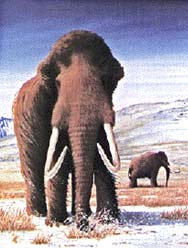Recently, a study was published according to which the woolly mammoths in Alaska and the Bering Sea became extinct only at the end of the Pleistocene period, about 11,000 years before our time
Alluvial container, Galileo

Prof. Dale Guthrie (Guthrie) and Marie Gilbert (Gilbert) from the Institute for Biological Research in the Arctic Region, from the University of Alaska, recently published an article according to which woolly mammoths in Alaska and the Bering Sea became extinct only at the end of the Pleistocene period, about 11,000 years before our time.
Improved testing
Guthrie and Gilbert performed tests using an improved carbon 14 method of woolly mammoth fossils in the Americas preserved on some islands in the Bering Sea. This is mainly the island of St. Paul, which in the past contained grasslands that were needed by mammoths as a food source. According to them, during the last ice age, the water level was about 120 meters below the current sea level, at which time the islands in the Bering Sea rose higher and therefore their area was larger.
In those days there was a land connection between Asia and America in the area where the five islands are located. They based their studies not only on the improved carbon 14 method but also on testing the estimated water depth in the different periods, measurements of the rate of shrinkage (or expansion) of the Bering Sea and more.
When the St. Lawrence was Alaska
According to Guthrie, there is no longer any doubt that the mammoths survived for sure until about 13,000 years ago, and that they became extinct mainly during the Holocene period (ie: our time), when the sea level rose and went up after the peak of the ice age, and that carbon 14 tests confirm that the main extinction The mammoth extinction happened about 11,500 years before our time, when the island of St. Lawrence was still part of mainland Alaska.
In contrast, St. Paul Island was a true island about 1,500 years earlier, while there is an identity between the St. Lawrence Island and mainland Alaska extinction dates. Additional samples taken in St. Paul show similar signs of mammoth extinction on this island only 7900 years ago, during the much later Middle Holocene. It seems that in those days the island provided the mammoths with plenty of food, and that because of its size they may not have suffered from genetic problems resulting from "inbreeding", while today its area reaches only about 90 square kilometers.
Since the findings show that the island reached its current size about 5,000 years ago only about XNUMX years ago, it is now assumed that it is not impossible that the woolly mammoths survived until that time, and hence we could almost see them with our own eyes, similar to our observations of their relatives the elephants.
